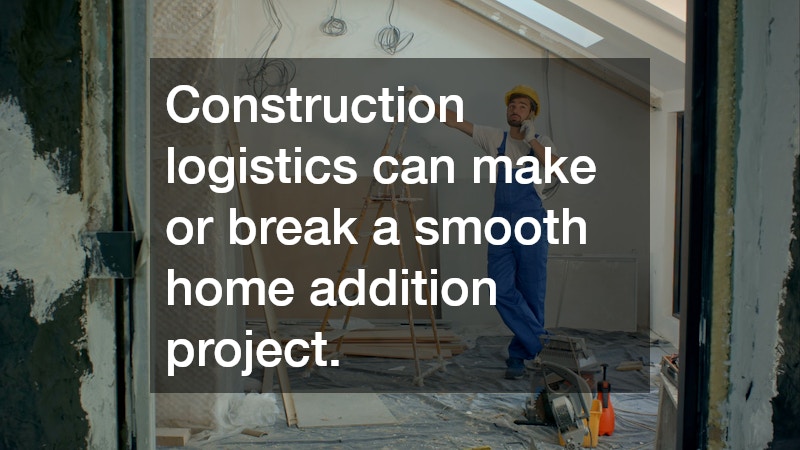
Adding space to your home is an exciting opportunity to improve functionality, increase comfort, and enhance property value. Whether you’re thinking of expanding a living room, adding a bedroom, or remodeling your kitchen, a well-planned home addition requires attention to detail, careful budgeting, and coordination of multiple services. The process can feel overwhelming, but breaking it down into manageable steps ensures a smoother, stress-free experience. From design considerations to safety measures, this guide covers practical strategies for planning a home addition that meets your family’s needs without unnecessary complications.

1. Define Your Goals and Budget Clearly
Before any construction begins, it’s crucial to clarify the purpose of your home addition and establish a realistic budget.
Key considerations:
-
Identify needs vs. wants: Determine which spaces are essential for your family’s lifestyle, such as extra bedrooms, home offices, or expanded living areas. Consider potential future needs as well.
-
Budget realistically: Include construction costs, materials, labor, permits, and contingency funds for unexpected expenses. Factor in ongoing maintenance for new spaces.
-
Work with experts: Collaborating with experienced home builders ensures that your budget aligns with project feasibility. They can provide estimates, suggest cost-effective solutions, and identify potential hidden expenses early on.
Tips for effective planning:
-
Make a list of priorities and rank them by importance.
-
Research average costs for similar projects in your area.
-
Set aside at least 10–15% of your budget for unforeseen costs.
A clear understanding of your goals and financial boundaries helps prevent overspending, reduces stress, and ensures that the project reflects your vision.
2. Choose the Right Design for Your Home
Selecting a design that complements your home’s existing structure and enhances functionality is essential.
Considerations:
-
Flow and layout: Ensure that the new space integrates smoothly with existing rooms. Consider natural light, traffic flow, and access points.
-
Style consistency: Your home addition should match the architectural style and finishes of the rest of your house to maintain a cohesive look.
-
Functional updates: Incorporate kitchen updates or other high-use areas during planning to maximize utility.
Working with professionals:
-
Partnering with architectural design homes specialists allows you to visualize layouts, review 3D models, and refine plans before construction begins.
-
Professionals can also identify potential challenges, such as structural limitations or code requirements, and provide innovative solutions.
Actionable tips:
-
Create mood boards or visual references to communicate your style preferences.
-
Ask designers to provide multiple layout options and explain the benefits of each.
-
Consider future-proofing spaces for evolving family needs.
Thoughtful design ensures the addition enhances your home’s aesthetics and livability while minimizing costly adjustments during construction.
3. Plan for Construction Logistics
Construction logistics can make or break a smooth home addition project. Proper planning ensures safety, efficiency, and minimal disruption.
Outdoor space considerations:
-
Evaluate your yard for landscaping, trees, and access for construction equipment.
-
If necessary, hire a tree company or tree removal company to clear or protect trees, ensuring safe site preparation.
-
Schedule heavy equipment deliveries to minimize damage to your property.
Coordination strategies:
-
Establish clear timelines for each phase of construction.
-
Confirm that contractors and subcontractors understand site restrictions and safety protocols.
-
Plan storage and staging areas for materials to prevent clutter and hazards.
Tips for success:
-
Map out construction zones, marking where vehicles and equipment can safely operate.
-
Communicate with neighbors about potential disruptions to avoid conflicts.
-
Keep emergency contacts and insurance information readily available.
Proactive logistics planning helps avoid delays, protects property, and keeps the project on track, especially when coordinating with a trusted tree company to manage nearby trees and prevent damage during construction.

4. Address Health and Safety Concerns Early
Home additions can expose your family to hidden hazards if precautions aren’t taken.
Potential risks:
-
Mold growth due to construction moisture or pre-existing leaks.
-
Accumulated debris creates safety hazards.
Preventive measures:
-
Hire mold remediation specialists to inspect and address moisture or contamination issues before construction.
-
Use junk removal services to clear debris, old furniture, or appliances from work areas.
Benefits of early intervention:
-
Maintains a safe environment for your family and workers.
-
Prevents long-term health problems associated with mold or dust.
-
Reduces the risk of construction delays caused by site hazards.
Tips for homeowners:
-
Schedule regular site cleanups throughout the project.
-
Ensure workers wear appropriate protective gear.
-
Monitor indoor air quality during and after construction.
Integrating health and safety planning into your addition ensures a cleaner, safer, and more efficient project.
5. Coordinate Interior Spaces Thoughtfully
6. Select Reliable Professionals
7. Obtain Necessary Permits and Approvals
Securing the proper permits is a critical step in home addition planning.
Permit considerations:
-
Building permits for structural changes.
-
Electrical and plumbing approvals.
-
Compliance with local zoning codes and regulations.
Professional assistance:
-
Architectural design homes specialists often assist with permit submissions.
-
Experienced home builders understand local regulations and streamline the approval process.
Tips for homeowners:
-
Keep copies of all permits and inspection reports for reference.
-
Schedule inspections at key milestones to avoid delays.
-
Communicate with municipal authorities to clarify any questions.
Proper permitting prevents legal issues, fines, and project delays, keeping your addition on track.

8. Evaluate Materials, Equipment, and Technology
Selecting high-quality materials and incorporating modern technology are crucial steps in ensuring a home addition is both durable and efficient. Investing in the right products and systems not only enhances functionality but also adds long-term value to your property.
Considerations:
-
Choose long-lasting, sustainable materials for construction, flooring, and finishes. Materials that resist wear, moisture, and temperature fluctuations reduce the need for frequent repairs.
-
Incorporate advanced systems, such as energy-efficient water pressure tanks or air duct repair solutions, to lower energy consumption and maintain optimal indoor air quality.
-
Use precision tools and installation techniques to minimize errors, ensuring structural integrity and superior performance.
Tips:
-
Compare product warranties, energy ratings, and manufacturer reputation before making purchases to ensure reliability.
-
Consult specialists for recommendations on materials and systems best suited to your local climate, soil conditions, and architectural design.
-
Consider technologies that enhance comfort, such as smart thermostats, automated HVAC controls, or efficient air circulation systems.
-
Factor in ease of maintenance and long-term cost savings when selecting materials and equipment.
By prioritizing quality materials and leveraging modern technologies, homeowners can create a home addition that is not only visually appealing but also energy-efficient, safe, and built to last. These thoughtful choices help maximize comfort, reduce operational costs, and increase the overall value of the property.
9. Schedule Maintenance for Long-Term Home Protection
Ongoing maintenance is essential to protect your home addition investment and ensure that all systems operate efficiently over time. Neglecting routine upkeep can lead to costly repairs, structural damage, and reduced comfort, so scheduling regular check-ins with professionals is critical.
Critical maintenance points:
-
Schedule seasonal roof inspections and services from a local HVAC repair company to identify potential issues before they escalate.
-
Maintain water systems, HVAC units, and roofing to prevent leaks, mold growth, and other long-term damage.
-
Inspect plumbing, electrical, and insulation systems periodically to ensure optimal performance and energy efficiency.
Maintenance checklist:
-
Examine roofing, gutters, and downspouts for debris, damage, or water pooling.
-
Schedule air duct cleaning, AC servicing, and filter replacement to maintain indoor air quality and system efficiency.
-
Monitor water pressure tanks and plumbing fixtures to catch leaks or irregularities early.
-
Keep detailed records of all inspections, repairs, and servicing to track trends and provide documentation for warranties or resale purposes.
Additional tips:
-
Coordinate seasonal maintenance to reduce disruptions and consolidate contractor visits.
-
Engage local service providers familiar with your home’s systems for tailored advice and timely repairs.
-
Implement a preventive maintenance schedule rather than reacting to problems, which reduces stress and unexpected costs.
By committing to regular, well-documented maintenance, homeowners can prolong the life of their home addition, maintain safety and comfort, and preserve property value for years to come.
10. Coordinating Multi-Service Upgrades
Home additions often involve multiple trades working simultaneously, including roofers, asphalt companies, plumbing specialists, and interior contractors. Without careful coordination, overlapping schedules, miscommunications, and unexpected delays can turn a well-planned project into a stressful experience. Effective management of all moving parts is essential to ensure efficiency, reduce downtime, and maintain a high-quality outcome.
Tips for synchronization:
-
Align project timelines between all contractors, ensuring that exterior work, interior remodeling, and utility installations occur in a logical sequence.
-
Verify communication between teams to prevent scheduling conflicts or overlapping tasks that could damage work already completed.
-
Consolidate inspections, permits, and approvals to streamline the project and avoid repeated visits from inspectors.
-
Use a centralized project management system or regular coordination meetings to keep every team updated on progress, changes, and potential issues.
Benefits of coordinated upgrades:
-
Enhances home aesthetics and functionality by ensuring that each component complements the others seamlessly.
-
Reduces disruption to daily life by minimizing construction downtime and preventing repeated interruptions.
-
Saves time and prevents costly errors or rework caused by misaligned tasks or miscommunication.
-
Improves accountability, as contractors are aware of each other’s schedules and responsibilities.
By fostering collaboration and maintaining clear oversight, homeowners can enjoy a smoother construction experience. Coordinated efforts make the process more predictable, help keep budgets under control, and deliver a home addition that meets expectations in both quality and timeline.
Planning a home addition doesn’t have to be overwhelming. By defining clear goals, selecting experienced professionals, coordinating construction logistics, and prioritizing health, safety, and permits, homeowners can create a seamless process that results in functional, beautiful spaces. Thoughtful design, careful material selection, and multi-service coordination ensure that your addition enhances comfort, efficiency, and property value. Maintaining detailed records, scheduling ongoing maintenance, and fostering open communication with contractors further protects your investment.
With preparation, proactive planning, and the right team, your home addition can transform your living space without the stress or surprises often associated with construction projects. Whether expanding your kitchen, adding bedrooms, or remodeling interiors, a strategic approach ensures a successful, rewarding experience for years to come.


